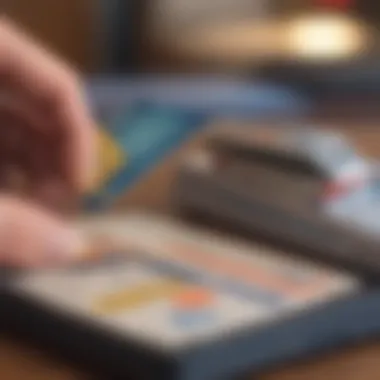Guide to Checking Your BMO Debit Card Balance


Intro
Understanding your BMO debit card balance is crucial in navigating the tangled web of personal finance. It's not just about knowing how much money is in your account; it's about empowering yourself with information that can help you make sound financial choices. When you have a finger on the pulse of your finances, you're less likely to stumble into overdraft fees or exceed your budget limits. This guide aims to take you through every turn and corner of checking your BMO debit card balance, combining techniques, tools, and strategies you can seamlessly integrate into your financial practices.
With a variety of methods available, from digital apps to traditional statements, knowing how to access your balance swiftly can save you from unnecessary frustration. Plus, keeping tabs on your spending habits can also lead to better budgeting and savings strategies. Throughout this article, we’ll dive into these aspects thoroughly. From common pitfalls in balance checking to useful tips that can improve your financial literacy, you’ll find everything you need to enhance your banking experience.
Let’s map out our path through the crucial points that will follow, ensuring you emerge with practical knowledge that you can utilize right away. Whether you are a tech-savvy individual or someone who prefers pen and paper, this guide has got you covered.
Prolusion to BMO Debit Cards
BMO debit cards serve as a convenient financial tool, linking directly to your bank account, helping you manage daily transactions without the hassle of carrying cash. These cards are not just simple plastic; they embody a gateway to greater financial independence, allowing you to make purchases at a variety of locations with just a swipe. Moreover, they tend to provide access to numerous features like cash withdrawals, online shopping capabilities, and rewards programs, depending on the specific card you hold. The widespread acceptance of BMO debit cards across retailers also enables seamless transactions, which greatly enhances their utility.
Understanding Debit Card Functionality
The functionality of a BMO debit card extends far beyond just acting as a payment method. At its core, it automatically deducts funds from your linked checking account at the moment of purchase, ensuring you spend only what you have. This immediate deduction can help instill a thrifty mindset, keeping you grounded as you keep tabs on your finances.
Additionally, debit cards often come equipped with various features like:
- Security Measures: With chip technology and PIN requirements, they offer a layer of protection against fraud.
- Budgeting Tools: Some BMO debit cards allow integration with budgeting apps, making it easier to track spending patterns.
- ATM Accessibility: Withdraw cash as needed without straying from your budget.
In essence, understanding how your BMO debit card operates can significantly enhance your financial lifestyle, making it crucial for informed usage.
Importance of Monitoring Your Balance
Keeping an eye on your BMO debit card balance is not just a suggestion; it’s a necessity. Regularly monitoring your balance helps prevent overspending and ensures that you maintain control over your financial situation. Ignoring it can lead to a cascade of financial headaches, from overdrafts to unnecessary fees.
Several key reasons illustrate why balance monitoring is paramount:
- Avoidance of Overdraft Fees: Knowing how much you have reduces the urgency that could lead to overspending and falling into overdraft territory.
- Transaction Tracking: By checking your balance, you rid the uncertainty surrounding your purchases. This offers peace of mind and clarity.
- Fraud Detection: Frequent balance checks help catch unauthorized transactions early on, acing the chance to mitigate potential losses.
Monitoring your balance, therefore, not only safeguards your financial health but also promotes a disciplined and mindful approach towards spending.
Methods to Check BMO Debit Card Balance
Checking your BMO debit card balance is an essential step towards effective money management. Understanding the methods available for balance inquiries allows cardholders to keep tabs on their spending and avoid unwanted overdraft fees. Gaining insight into this aspect not only empowers users to manage their finances wisely but also supports better decision-making regarding purchases and budgeting.
Using Online Banking
Accessing the BMO Website
To start with online banking, accessing the BMO website is the first step. This platform is designed with user experience in mind, presenting an array of features that facilitate smooth transactions and balance checks. One of its key characteristics is that it offers a centralized hub where users can view their accounts with ease, making it a popular choice for many.
A unique feature of the website is the seamless navigation flow. By strategically placing information, it reduces the time spent searching for the necessary details, making it an advantageous resource. However, sometimes users might feel overwhelmed by the number of options available.
Logging Into Your Account


Once on the BMO website, logging into your account is the next crucial step. This process enhances security, ensuring only authorized users can check balances and manage transactions. The main appeal of this method is the sense of safety it provides.
Users enter their credentials, which not only safeguards personal information but also connects them to financial insights. The disadvantage could include forgetting login information, which can lead to frustration. Still, the security features outweigh the inconvenience.
Locating Balance Information
After logging in, locating balance information becomes straightforward. The design is intuitive, often presenting the balance on the main dashboard. This accessibility is a key characteristic because it enables quick financial assessment.
Users can quickly glance at their available funds without navigating multiple tabs. Though this method is typically efficient, there can sometimes be discrepancies between the displayed balance and real-time figures. On the other hand, it serves as a reliable first stop for checking finances.
Mobile App Access
Downloading the BMO App
In today's mobile-centric world, downloading the BMO app offers unparalleled convenience. The app is feature-rich, encouraging individuals to engage with their finances on the go. One of its primary characteristics is the ability to do everything from checking balances to managing alerts with ease.
Jumping into the app, users find familiar functionality as the website, making it user-friendly. A unique advantage is that it allows balance checks in seconds, regardless of location. Yet, some users may face challenges with app updates, potentially interrupting accessibility.
Steps for Balance Checking
Once the app is downloaded, the steps for balance checking are pretty straightforward. Users simply open the app, log in, and can view their balance immediately. This ease of access is a substantial benefit, particularly for those who are frequently on the move.
The unique feature here is the real-time updates it offers. Customers can trust the balance shown, which is refreshing. However, not every smartphone may support the latest app version, posing a minor disadvantage for some.
Customization of Alerts
Another appealing aspect of using the app is the customization of alerts. Users can set notifications for when their balance drops below a specified amount. This feature plays a pivotal role in proactive financial management.
By tailoring alert settings to fit personal spending patterns, users can receive timely notifications about their finances. This adaptability is beneficial for staying informed. Conversely, some might find the inundation of alerts distracting, but overall, this tool significantly enhances financial awareness.
Automated Teller Machines (ATMs)
Finding BMO ATMs
Another way to check your balance is via finding BMO ATMs. These machines are strategically located for ease of access, ensuring that users don’t have to travel far. A notable characteristic of these ATMs is their user-friendly interface, which guides customers through the process of checking their balance smoothly.
A unique benefit with BMO ATMs is that they commonly offer language options, enhancing accessibility. However, it might be frustrating to find that not every machine supports balance inquiries, so users may need to locate one that does.
Using Card at ATMs
When you arrive at an ATM, using your card at ATMs is the next step. This method is direct – insert the card, follow prompts, and your balance is at your fingertips. Its straightforward nature is its best feature since users can directly access their balance without logging into any platform.
However, for those unfamiliar with ATM operation, there can be a small learning curve. Still, it remains a reliable option for balance checks.
Interpreting Balance Receipts


Upon checking your balance at an ATM, you may also opt to take a receipt. Interpreting balance receipts is crucial, as they often show not just your current balance but any recent transactions as well. Understanding the information printed on these slips can provide insight into spending habits.
The advantage of using receipts is they serve as a tangible reminder of your financial state. However, people sometimes misread these slips, leading to confusion. Nevertheless, they can help users create a clearer picture of their banking situation.
Phone Banking Services
Contacting Customer Service
If all else fails, consider contacting customer service. This approach allows for personalized assistance tailored to your unique concerns. This method boasts a human touch, allowing users to explain their issues directly.
One significant advantage is the ability to receive guidance on more complex inquiries. Nonetheless, hold times can vary, potentially making this option less appealing for someone looking for an immediate answer.
Using Automated Systems
Another option is using automated systems to check your balance. These systems are generally available 24/7, providing an alternative when staff assistance isn't possible. One of its strengths is that it saves time as users can obtain balance information without waiting for a representative.
On the downside, not every inquiry may be addressed by these systems, leading to potential dead ends. Still, for those who have straightforward requests, this method is practical.
Verification Procedures
Lastly, navigating verification procedures is a critical aspect of using phone banking. Customers may need to answer security questions to verify their identity before getting sensitive information. This is a vital component of safeguarding personal data.
While these procedures ensure security and protect against fraud, they can sometimes feel cumbersome. Nonetheless, having robust verification steps reinforces the importance of securing one’s finances.
Understanding Your Balance
Navigating the world of personal finance can sometimes feel like walking a tightrope—one misstep, and you could find yourself in a tough spot financially. That’s why understanding your bank account balance, especially when it comes to managing your BMO debit card, is crucial. It’s not just numbers on a screen; it’s a reflection of your spending ability, your financial health, and, to some extent, your lifestyle choices.
When it comes to your BMO debit card, knowing the distinction between your available balance and your current balance is key. Grasping these concepts can save you from a world of trouble, such as overdrafts or declined transactions, which can happen just when you least expect it.
Moreover, being aware of your balance helps in crafting a budget that suits your needs and goals. It’s the foundation upon which you can build smart financial decisions. If you keep a close eye on these figures, you’re more likely to avoid those pesky surprises that often lead to stress.
Available Balance vs. Current Balance
In the realm of banking, the terms available balance and current balance are frequently used interchangeably, but they are anything but identical. Understanding their distinctions offers a clearer view of your actual financial standing.
- Available Balance: This figure shows the amount of money you have access to spend right now. It factors in any pending transactions, which means if you have a few purchases that haven't cleared yet, these amounts are subtracted from your total.
- Current Balance: This number represents all your funds on deposit in the account at the moment, including those pending transactions. It’s less useful for immediate spending decisions, since it doesn’t show what you can actually use right now.
Being aware of these differences informs your financial decisions effectively, especially when making significant purchases. If you're at the store and your available balance shows less than you anticipate, you’ll know to hit the brakes.
Pending Transactions and Their Impact
Pending transactions—those enigmatic entries that take a bit to clear—can be both a friend and a foe. Understanding how they affect your financial standing is vital for maintaining a healthy account. A pending transaction is basically a transaction that you have authorized but that has not yet fully processed. It can include direct debits, credit card payments, or even that fancy latte you picked up at the café.
While these transactions have not formally deducted from your available balance, they do create a bubble of uncertainty. Here are several implications:


- Budgeting Uncertainty: If you’re unaware of pending transactions, you might end up overspending, thinking you have more available cash than you truly do. This can lead to unnecessary fees or overdraft issues, which nobody wants.
- Cash Flow Management: Monitoring pending transactions enables you to manage your cash flow better. You can anticipate when significant payments are going to clear so you can prepare.
- Informed Decision Making: When you have a clear idea of what’s pending, you can determine if there’s room for additional purchases or if you might want to hold off on that splurge.
Common Issues When Checking Your Balance
In the realm of debit card management, awareness of potential hiccups can save you both time and frustration. It's crucial to recognize that while checking your balance seems straightforward, it can be clouded by various common issues. Understanding these can help to streamline your financial activities, ensuring that you remain in control of your funds.
Technical Difficulties
Technical glitches are not just nuisances; they can be real roadblocks. Sometimes, you may find yourself unable to access your account due to server downtime or website maintenance. For instance, on particularly busy banking days, the system might slow down, affecting your ability to log in or retrieve account details.
Additionally, the BMO mobile app might experience crashes or bugs, preventing you from easily checking your balance. These tech-related frustrations can lead to missed transactions or failed payments, which, in turn, can result in additional fees or overdraft situations. To mitigate this:
- Regularly Update Your App: Keeping your mobile app updated can help avoid crashes caused by outdated software.
- Check System Status: If you encounter difficulties, visit the BMO website or their social media pages for live updates concerning system outages.
- Use Alternative Methods: If online or mobile methods are down, always have a backup plan to check your balance, such as using an ATM or contacting customer service.
Misunderstanding Balance Figures
Often, individuals may misunderstand the figures displayed when checking their balance. For instance, banks typically present two figures: the available balance and the current balance. The current balance reflects all transactions that have been processed, while the available balance indicates what you have access to spend immediately.
This distinction is paramount. Imagine planning a purchase based on your current balance without realizing that pending transactions haven't cleared yet; you'd be setting yourself up for disappointment. Misinterpretations like this can lead to overdrafts or declined transactions, causing unnecessary stress. To avoid this:
- Always Review Pending Transactions: Keep an eye on what's pending to get an accurate idea of your financial standing.
- Know the Difference: Be well-versed in the difference between the available and current balance; it could save you from lots of trouble.
- Utilize Alerts and Notifications: Enable notifications for transactions or balance changes. This keeps you informed and can reduce confusion regarding your account status.
Understanding these common issues not only helps in avoiding mishaps but also empowers you to handle your finances smartly. Remember, a little insight can go a long way in financial management.
Best Practices for Managing Your Debit Card
Managing a debit card effectively goes beyond simply checking the balance. It's about creating a structured approach to spending and monitoring transactions. Best practices for managing your BMO debit card can lead to heightened financial awareness, reduced unnecessary expenses, and improved overall financial health. By adopting these practices, users can not only keep their accounts in the black but also build a strong foundation for future financial decisions.
Regularly Monitoring Transactions
To stay ahead of the game with your BMO debit card, regularly monitoring your transactions is crucial. This is akin to keeping a vigilant eye on the road while driving; it helps prevent potential hazards before they become critical issues. Here’s why this practice matters:
- Identifying Unauthorized Transactions: Sometimes, fraud can slip through the cracks. By routinely checking your account, you can spot dubious transactions early and take action, such as reporting them to BMO.
- Understanding Spending Patterns: Keeping tabs on your transactions helps you identify where your money is going. Do you spend too much on coffee? Or maybe impulse buys at retailers? By understanding your patterns, you can make necessary adjustments.
- Budget Adherence: Understanding your transactions will help in sticking to your budget. You can see which categories are being overspent and which ones you can tighten up on.
Closure
In our fast-paced financial landscape, understanding how to effectively manage your BMO debit card balance stands as a vital priority. This article has illuminated various aspects that contribute to not only keeping track of your available balances but also making informed, strategic decisions regarding personal finances. As we distill the nuances of checking your balance, it becomes clear that the methods available—be it via the online banking portal, mobile application, ATMs, or telephone banking—provide different pathways for financial transparency. By selecting the right method for your needs, you gain a clearer picture of your financial standing and can avoid unpleasant surprises.
Recap of Balance Checking Options
- Online Banking: Log into your BMO account to see your balance instantly. The platform is user-friendly, allowing you to check your spending history at the same time.
- Mobile App: With BMO’s app, balances are just a tap away. Customize alerts to notify you when your balance hits a certain threshold.
- ATMs: Visiting a BMO ATM can give you immediate access to your current balance, along with cash withdrawals, which can be handy in a pinch.
- Phone Banking: If you prefer a personal touch, customer service can guide you through balance inquiries, while automated systems can help you perform quick checks without needing to be on hold.
While the options may seem plentiful, they each offer unique advantages depending on how tech-savvy you feel or where you find yourself at any given moment. Proficiency in accessing this critical balance information can set the stage for more proactive financial planning across various scenarios.
Encouragement for Proactive Financial Management
Taking charge of your financial future begins by fostering a habit of regular monitoring. Proactivity in managing a BMO debit card balance isn't merely about keeping numbers in check; it's about understanding what those numbers mean in the context of your broader financial goals.
Structural insights to keep in mind include:
- Keeping an eye on your available balance can prevent overspending, ensuring that you are never caught off guard by unexpected bills.
- Examining pending transactions sheds light on forthcoming changes to your balance, thus allowing you to operate with foresight rather than hindsight.
A person’s financial behavior can transform with even simple awareness; when you know your balance and its implications, you become empowered to make decisions that align more closely with your financial ambitions. Whether you're trying to save a little extra for a vacation or planning for a future investment, regular balance checks and mindful spending can build a solid foundation.



